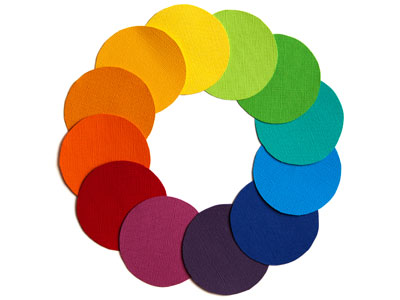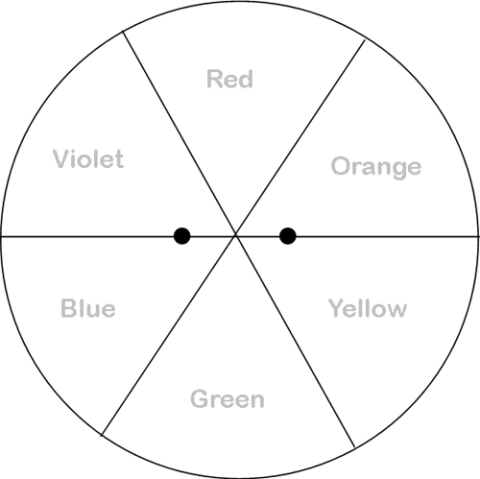What is white light?

Circle of colours (eden04, iStockphoto)

Circle of colours (eden04, iStockphoto)
How does this align with my curriculum?
Find out what happens if you spin the colours of the rainbow in this hands-on activity.
What You Need
- Scissors
- Pencil
- Markers or paint
- White poster board
- Thin string of thread (1m)
- Darning/yarn needle or hole punch
- Glue
- Wheel template
Safety First!
Provide assistance when using the darning/yarn needle as the point may be sharp.
What To Do
- Colour the triangles on the wheel using the colours (red, orange, yellow, green blue, and violet)
- Cut out the wheel template and trace onto the poster board.
- Cut out the poster board circle.
- Glue the coloured wheel onto the poster board circle.
- Poke holes in your wheel where indicated.
- Thread your string through each hole and tie the ends of the string together.
- Pull the wheel so that it is in the middle of the string.
- Holding the two ends of the string with at least 2 fingers, swing the circle towards you 20 times so that the string is twisting.
- Pull your hands apart. The wheel should spin quickly. Move your hands closer together and the string should twist up again. Repeat until you have a good rhythm (this may take a few tries; when it is working, it makes a whirring sound)
- Look at the spinning wheel. What colour(s) do you see?
Video Instructions
Wheel Template
Discovery
Natural light is made up of many different colours. If we slow this light down by making it pass through a prism (or water droplets in the case of a rainbow) it will break up into different colours. The opposite is also true when we have separate colours and make them travel together quickly - our eyes will see them as one colour. If we used all the colours of the rainbow on our wheel and made it spin really fast, it would appear as white.
We see the world in a wide range of colours. We see different colours because each object absorbs and reflects light in different ways. These colours can be organized into a visible spectrum – the range of colours that our eyes can see. The colours on the spectrum are red, orange, yellow, green, blue, indigo, and violet (the rainbow!). A rainbow forms because when rain is falling, light from the sun bends as it passes through all the water. Although light from the sun may appear as white, as a result of this bending motion, we can see the sun’s true colours.
- Create wheel using just two colours (e.g. red & blue, blue & yellow, red & orange) What happens when you spin the wheel now?
For more information on this topic check out these Let's Talk Science resources:
- How do I see colour? (Hands-on Activities) - In this STEAM activity make a colourful light catcher and discover why we see different colours?
- Light and Its Properties (Backgrounders) - Learn about light and its properties.
- How We See (Backgrounder) - Learn about how human vision works as well as some common types of vision problems.
- Why do we need two eyes to see? (Hand-on Activities) - Ever wondered why we have two eyes (and not one, three or more)? Find how your two eyes work together in this hands-on activity.
What’s happening?
Natural light is made up of many different colours. If we slow this light down by making it pass through a prism (or water droplets in the case of a rainbow) it will break up into different colours. The opposite is also true when we have separate colours and make them travel together quickly - our eyes will see them as one colour. If we used all the colours of the rainbow on our wheel and made it spin really fast, it would appear as white.
Why does it matter?
We see the world in a wide range of colours. We see different colours because each object absorbs and reflects light in different ways. These colours can be organized into a visible spectrum – the range of colours that our eyes can see. The colours on the spectrum are red, orange, yellow, green, blue, indigo, and violet (the rainbow!). A rainbow forms because when rain is falling, light from the sun bends as it passes through all the water. Although light from the sun may appear as white, as a result of this bending motion, we can see the sun’s true colours.
Investigate further
- Create wheel using just two colours (e.g. red & blue, blue & yellow, red & orange) What happens when you spin the wheel now?
For more information on this topic check out these Let's Talk Science resources:
- How do I see colour? (Hands-on Activities) - In this STEAM activity make a colourful light catcher and discover why we see different colours?
- Light and Its Properties (Backgrounders) - Learn about light and its properties.
- How We See (Backgrounder) - Learn about how human vision works as well as some common types of vision problems.
- Why do we need two eyes to see? (Hand-on Activities) - Ever wondered why we have two eyes (and not one, three or more)? Find how your two eyes work together in this hands-on activity.
